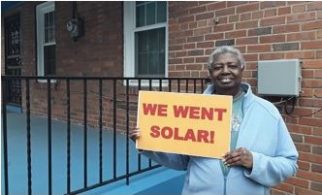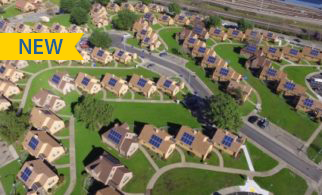Hawaii
Hawaii is undergoing an aggressive energy transformation, aimed at helping the state achieve its 100 percent renewable portfolio standard by 20451. With one of the highest customer electrical rates in the country, it was critical that Hawaii take strategic steps to achieve energy democratization, to remove barriers to financing, to expand access, and to reduce energy burdens across the state.2 The State’s Green Energy Money $aver (GEM$) is an on-bill financing program, offered by the Hawaii Green Infrastructure Authority (HGIA), for low and moderate-income households, renters, nonprofits, small businesses,3 and multi-family rental projects. On-bill financing allows states or utilities to provide loans or tariffs for energy efficiency and renewable energy upgrades. Either the utility or a third-party lender, which in this case is the State of Hawaii, will pay the upfront cost of the energy upgrade, and the customer repays the loan over time on their utility bill. Since the opening of the program, GEM$ has provided a total of 217 residential loans/leases to underserved markets for solar photovoltaic projects.4 20 percent of funds are allocated to low and moderate income single family residential homeowners and renters, and 35 percent of funds are allocated to multi-family rental projects.5
History of On-Bill Financing in Hawaii
The Hawaii State Legislature found that the upfront cost of renewable energy systems and energy was a large barrier for residents and businesses in the state.6 Act 204, 2011 Session Laws of Hawaii directed the Public Utility Commission “to investigate the viability of an On-Bill Financing Program.”7 Act 211, 2013 Session Laws of Hawaii, established HGIA in 2014 to deploy low-cost financing to make green infrastructure more accessible and affordable. HGIA was capitalized with $150 million in Green Energy Market Securitization (GEMS) Bonds and tasked with supporting green infrastructure investments. In 2016 the Public Utility Commission directed the Hawaiian Electric Companies to work with HGIA to design and implement an on-bill financing mechanism in the form of the Green Energy Money $aver (GEM$) On-Bill Financing Program.
How does the GEM$ Program work?
The GEM$ Program is exclusively offered by HGIA, and uses a combination of public and private dollars to provide customers energy improvement upgrades. As the program administrator, HGIA is focused on providing access to low-income communities and households that have historically been locked out of clean energy due to financial barriers. Program participants are eligible if: (1) they are a ratepayer in the appropriate service territory; (2) they have not received a disconnection notice from the utility in 12 consecutive months; and (3) they are classified as either a nonprofit, small business, multi-family rental project, or commercial tenant.8 Due to the high cost of housing, approximately 43 percent of Hawaiian households rent, therefore the program is designed for low and moderate-income households, renters, nonprofits and other hard to-reach segments.” 9
After eligibility is determined, the applicant is able to select a GEM$ approved contractor who is responsible for submitting proposed energy improvement information to HGIA. Each energy improvement upgrade must provide a minimal of 10 percent utility bill savings to the customer.10 Once a project is approved and completed HGIA pays the contractor for the completed project. The loan repayment information goes through HGIA’s Loan Servicer, and then to the utility before it shows up as a monthly charge on the customer’s utility bill.
Polynesian Cultural Center Couples On-Bill Financing and Power-Purchase Agreements
The Polynesian Cultural Center, located on Oahu, is a top attraction drawing in thousands of tourists each year. The Cultural Center was one of the first projects to receive approval from HGIA for a 413kw solar PV system coupled with a Power-Purchase Agreement (PPA) to offset a portion of its energy costs. Through on-bill financing GEM$ incurs the cost of the clean energy upgrade, and the Cultural Center repays a fixed amount on their monthly utility bill. As a result of investments in clean energy technology, the Cultural Center is able to save on its energy cost and provide support to students at the nearby college.
Fundamentals for Success
For low income households the path to acquiring solar and energy efficiency upgrades are often met with barriers. Factors such as limited credit history and perceived risk are reasons investors and lenders tend to shy away. In September 2019 HGIA committed to setting fund allocations for specific segments of the population and committed to only lending to nonprofits, multi-family rental projects, small businesses, and low-to moderate income single-family residential homeowners and renters.11
Convenient repayment through the utility bill. The loan repayment appears on the customer’s utility bill as a separate line item. This is a convenience to the customer because it eliminates the need for a separate bill.
No Upfront Cost. HGIA provides up to 100% of the upfront capital needed for low income households to make the clean energy investment. The money is repaid on the utility bill by the customer over a 20-year period, which aligns with the warranty period/life expectancy of the panels.
Bill-savings. The clean energy upgrades are not designed to be an additional financial burden to low income households. With a minimum estimated 10% bill-savings requirement, the savings that customers accrue from the reduced energy use are greater than the monthly repayment amount. This is important because customers should12 see a reduction on their electric bill. The loan should not be an added burden on households.
Credit Requirements. The GEM$ program only uses on-time 12 month utility payment history in lieu of credit scores. This helps to broaden the scope of who can participate and makes clean energy accessible to everyone. Individuals who do not have a bank account, or would not qualify for traditional loans are now able to participate.
Tied to the meter. Repayment of the loan is tied to the meter or the piece of property rather than the individual. This is beneficial to customers, especially renters, because they are able to reap the benefits of the clean energy upgrades while they live in the property and if they choose to move the loan repayment does not follow them.
Low interest rates or no interest rates are often offered with on-bill financing programs. This reduces the payment amount throughout the course of the loan, and contributes to bill neutrality. Lower interest rates or no interest rates can also increase customer participation.
Key Considerations for Program Design
There is no standardized approach to developing a successful on-bill program or even a green bank. Like Hawaii, policymakers will have to identify which principles of program design will meet the specific needs of their state. As innovative on-bill programs continue to emerge, leveraging lessons learned from Hawaii and other states will be important to their success. HGIA was forced to think carefully about designing a program that served the direct needs of their target populations. Key considerations for policymakers and program designers are:
Sources of Capital. The amount of capital needed to support an on-bill financing program depends on the program size. Financing for on-bill programs can come from ratepayer funds, public funding, bonds, foundations, and even individual investors. The Hawaii GEM$ program was capitalized with a $150 million Green Energy Market Securitization (GEMS) bonds.
Credit Enhancements can be a useful tool to help protect lenders from customers who default or are delinquent.When an investment portfolio looks risky, credit enhancements can mitigate risk. Depending on program design, credit enhancements can be designed in a way to meet program goals. For example, loan loss reserves allow you to set aside a pool of money that can be drawn from if losses are incurred due to default. Other credit enhancements include interest rate buy-downs, and loan guarantees.
Scalability is essential in that it helps you to determine how much capital you will need. Knowing the scalability of your projects can help you make decisions about participation, costs per person, fixed costs, and how many ratepayers you can serve. If there is inefficiency of scale investors may not be interested in providing capital. Aggregating smaller projects can make projects appealing and attract investors.
Program Administration. On-bill programs can be administered by utilities, state entities, nonprofit organizations, or another third party. The party chosen to administer your on-bill program must have a vested interest in the program’s success. They are responsible for overseeing all aspects of the program which includes, planning, directing overall operations, and resources. Hawaii’s Public Utilities Commission determined that HGIA would administer the state’s on-bill program, and for HGIA quality assurance has been an important component of program administration. For HGIA it is important to maintain the quality of service contractors provide. They vet all contracts to ensure they pay their taxes, how well they work with clients, and if contractors have the appropriate credentials.
Immediate Bill Savings. It is critical that ratepayers see the immediate benefits of the clean energy upgrades. Under the GEM$ program, clean energy upgrades must result in an estimated bill savings of at least 10 percent. When customers see the immediate benefits of their investment there is greater buy-in and customer retention.






